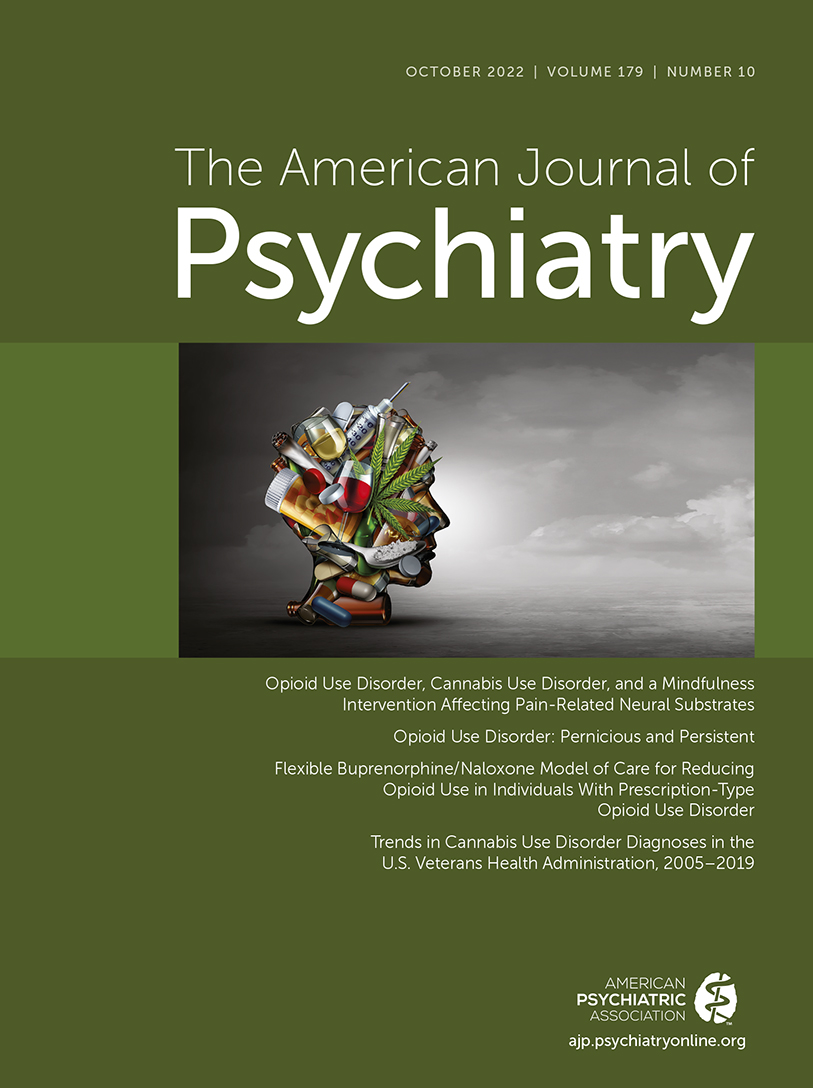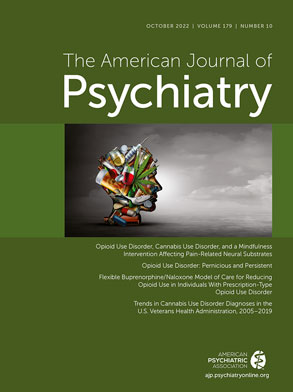Cannabis has long been one of the most used psychoactive substances worldwide. With substantial shifts in legal access to cannabis for medical and nonmedical purposes in Canada and more than 35 U.S. states and the District of Columbia, there is increasing interest in understanding both the therapeutic benefits and the potential health risks associated with its use. Approximately one in five people with past-year cannabis use will meet criteria for past-year cannabis use disorder (
1), and the risk is modified by a host of interacting sociodemographic, behavioral, genetic, and environmental factors. Veterans are a particularly important population to monitor for cannabis use disorder, as they have complex health care needs related to high rates of unemployment and homelessness, chronic pain and disability, and psychiatric and substance use disorders (
2).
In this issue of the
Journal, Hasin et al. examine trends in cannabis use disorder diagnoses among the U.S. Veterans Health Administration (VHA) patient population since 2005 (
3). Using records obtained for all veterans who received outpatient care at a VHA facility in the United States, the investigators calculated the annual proportion of patients ages 18–34, 35–64, and 65 or older who met criteria for cannabis use disorder, captured via ICD-9 (2005–2015) or ICD-10 (2015–2019) codes. Controlling for sex and race/ethnicity, the prevalence of cannabis use disorder increased between 2005 and 2019 in all three age groups: from 1.70% to 4.55% among those ages 18–34, from 1.59% to 2.86% among those ages 35–64, and from 0.03% to 0.74% among those age 65 or older. The authors also assessed trends by sex, noting that the increase in cannabis use disorder diagnoses was higher for males, except in more recent years (2016–2019) in the youngest age group, where females had a higher increase in cannabis use disorder diagnoses compared to their male counterparts. Finally, the authors compared prevalence of cannabis use disorder diagnoses over time by race/ethnicity and found that 1) Black patients were consistently more likely to be diagnosed with cannabis use disorder, and 2) relative to White patients, Black patients ages 18–34 and age 65 or older experienced a significantly greater increase in cannabis use disorder diagnoses across the study period.
The findings reported by Hasin et al. raise several additional questions to be addressed in future research. First, the rise in cannabis use disorder diagnoses occurred over a period in which several states legalized cannabis for medical or nonmedical purposes. Using cross-sectional data from the 2012–2013 National Epidemiologic Survey on Alcohol and Related Conditions (NESARC-III), Browne et al. recently demonstrated in the
Journal (
4) that veterans living in a medical cannabis state had significantly increased odds of meeting diagnostic criteria for cannabis use disorder, but the influence of state-specific cannabis laws on increases in cannabis use disorder diagnoses in the veteran population has yet to be determined. Hasin et al. consider the possibility that their findings were driven by shifts to products with higher THC potency. While THC potency has increased over time in jurisdictions where cannabis remains prohibited, concentrated THC products have overtaken a substantial share of the market in many legal states (e.g., cannabis concentrates constitute 30% of cannabis sales in Colorado [
5]). However, there is opportunity to mitigate harm in legal markets through regulatory options to curb consumer behavior (e.g., potency taxes), so establishing the influence of various policy structures on cannabis use disorder growth would be an important step to shed light on avenues to reduce harm.
Hasin et al. emphasize use of cannabis for self-management of chronic pain as one possible driver of the increase in cannabis use disorder diagnoses observed in the VHA patient population; posttraumatic stress disorder (PTSD) is also an important consideration. A recent analysis of state medical cannabis registry data showed substantial growth in patient medical cannabis registration since 2016, with chronic pain as the leading patient-reported qualifying condition in 2020 (60%), followed by PTSD (10%) (
6). Importantly, while cannabinoids have shown therapeutic benefit for certain types of chronic pain (e.g., neuropathic pain [
7]), the only randomized controlled study of smoked cannabis for PTSD did not show any short-term benefit (
8), and concurrent cannabis use disorder has been shown to reduce the likelihood of PTSD symptom reduction over time in veterans (
9). Future research should assess whether increases in efforts to manage PTSD with cannabis may have contributed to the increase in cannabis use disorder diagnoses observed in the VHA patient population. Understanding therapeutic and other motivations for cannabis use in veterans would help treatment providers guide patients toward potentially more beneficial and lower-risk treatment plans. Notably, only a small proportion (4%) of veterans who use cannabis report using it solely for medical purposes (
4), highlighting the importance of lower-risk cannabis use guidance (
10) for all patients who use cannabis, regardless of therapeutic intent.
The likelihood of cannabis use disorder diagnosis was highest among Black patients, and Black patients in the youngest and oldest age groups experienced greater increases in cannabis use disorder diagnoses over time. Hasin et al. propose multiple possible explanations for this finding, including increased consumption to cope with socioeconomic marginalization and racial discrimination and racial disparities in pain management leading more Black patients to self-manage pain with cannabis. Previous research has documented such racial bias in such health care settings. For example, in a study of VHA outpatients with HIV initiating long-term opioid treatment for chronic pain, although White patients were more likely to test positive for cannabis on a urine drug screen, Black patients were more likely to have their opioids discontinued following a cannabis-positive urine drug screen (
11). Hasin et al. point to survey data that help substantiate the interpretation that increased cannabis use disorder diagnoses among Black veteran patients likely reflect a true increase in cannabis use disorder risk in this population. However, it cannot be overlooked that drug laws have long been used as a tool of racial oppression in the United States (
12), contributing to racist stereotypes that associate Black people—particularly young Black men—with negative depictions of cannabis use (
13). If provider awareness of cannabis use disorder grew with legalization, but racial stereotypes were not curbed in tandem, we must consider the possibility that higher increases in cannabis use disorder observed among young Black patients were due to a higher rate of monitoring for cannabis use disorder in this group. As medical and nonmedical cannabis regulation continues to unfold across the United States, there is an ongoing need to monitor impacts on racial equity in diagnosing and treating cannabis use disorder in health care settings. It is critical to engage Black communities as equal partners in this research (
13).
The finding that males were more likely to be diagnosed with cannabis use disorder and generally experienced a greater increase in cannabis use disorder diagnoses over time is in line with epidemiological reports of higher prevalence of cannabis use among males over the years (
14). It is interesting that within the youngest age group, females experienced a greater increase in cannabis use disorder diagnoses in recent years. Epidemiological research has shown that even though males engage in more cannabis use, females transition from first use to problematic use at a faster rate (
15). Only recently have studies sought to probe underlying drivers of sex differences in the reinforcing effects of cannabis that contribute to the development and maintenance of cannabis use disorder. Our experimental research testing the acute effects of cannabis in males and females suggests that females are more sensitive to certain drug effects that may increase the likelihood of cannabis use disorder (
16), but many questions remain. It will be important to continue monitoring this trend of increased cannabis use disorder among young females in more recent years, especially as more cannabis products are being marketed specifically to women and for women’s health issues.
Although the prevalence of cannabis use disorder among VHA patients age 65 or older was lower than in other age groups, increasing diagnoses of cannabis use disorder in this group—particularly in the past 5 years—may signify that older veterans are gaining interest in trying cannabis as it becomes more normalized and legally accessible. For example, national survey data collected early after legalization in Canada showed that cannabis use among those age 65 or older increased at a faster pace than in any other age group (
17). This group also had the highest likelihood of recently initiating cannabis use, purchasing cannabis exclusively from legal sources, and using cannabis for therapeutic purposes (
17). It will be important to explore whether the highest increases in this age group occurred in regulated states and to investigate underlying usage patterns and therapeutic/nontherapeutic motivations potentially driving the observed increase in cannabis use disorder diagnoses among older veterans. While a recent exploratory study suggests that older adults may be less sensitive to cannabis’s cognitive effects (
18), there remains a large gap in our understanding of the risk-benefit profile of cannabis use in the aging population, and the findings highlight the need for education tailored specifically to older adults trying cannabis for the first time (or the first time in many years).
The Hasin et al. study provides a critical and timely update on rising cannabis use disorder diagnoses among VHA patients over the past 15 years, revealing important disparities in age, sex, and race/ethnicity that warrant further investigation. Clinical and policy decisions will be best informed by research that 1) explores underlying changes in cannabis consumption patterns and usage motivations within specific demographic groups, 2) measures the relative influence of various state-level cannabis regulatory policies, and 3) establishes the role of shifting provider awareness or unconscious bias in cannabis use disorder diagnosis and treatment.

